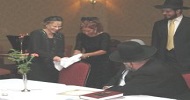When a Jewish couple gets engaged today, the process is pretty simple. The groom-to-be buys his fiancée a ring, places a picture in the local paper’s engagement section and voila! They’re engaged.
Things are more complicated for some Orthodox Jewish couples, but they still don’t approach the complexity of biblical times. In those days, engagement or betrothal, usually referred to as shiduchin, was a distinct, separate part of the marriage process.
Early Judaism barely recognized women—and some feminists would argue that things haven’t changed that much since then. Brides were purchased like chattel. The groom’s family paid a mohar (dowry) to the bride’s family; the woman then effectively became the groom’s property.
However, she remained in her father’s house until the marriage ceremony.
Although marriages were usually prearranged by the families, both young people had to give their full approval to the bond. We see this in Genesis 24:57, where the agents of both Laban and Abraham arranged for Rebecca to marry Isaac. Before the agreement was completed, Rebecca was asked for her consent.
By post-biblical and early Talmudic times, the betrothal or engagement ceremony became a highly festive occasion marked by feasting and celebration in the home of the bride’s father. The groom declared in the presence of two witnesses, “Be thou consecrated to me, be thou betrothed to me, be thou my wife.” The betrothal ceremony, which resembles our present-day wedding vows, could only be annulled by formal divorce. In some areas of ancient Israel, such as the Galilee, the betrothed bride and groom were kept strictly apart until marriage, whereas in nearby Judea, they were allowed to meet at the home of the bride’s father.
During the Middle Ages, the concept of marriage as a form of purchase agreement had dwindled, and the concept of betrothal as a separate event died out.
By the 12th century, the betrothal and wedding ceremony took place on the same day. And by the 15th century, the betrothal and marriage were performed simultaneously as a single event, which has evolved into our present-day marriage ceremony.
Among many Orthodox Ashkenazi Jews, remnants of the betrothal ceremony remain in the custom of tena’im, which means “conditions.” In the shtetls of Europe this was a formal ceremony, often celebrated on a semi-holiday such as Lag B’Omer, when a contract setting the wedding date and any prenuptial agreements was signed. If any of the tena’im were broken, many halakhic problems arose.
Since World War II, it has become usual to hold the tena’im ceremony just before the wedding so there is no chance clauses in the tena’im will be broken.
In a typical ceremony, the agreement is read by the rabbi and signed by the bride’s and groom’s parents. The couple’s mothers then break a china dish or piece of crockery over a chair or table. Pieces of the dish are kept by the parents. In some circles, any unmarried women on hand vie for a piece of the broken dish, as this is thought to be a favorable omen for their own future. Sometimes pieces of the china are made into jewelry, which is given to the bride’s friends.
The custom of breaking a dish at the tena’im ceremony arose in Germany during the Middle Ages when not just the couple’s mothers but also every woman at the ceremony smashed a dish she had brought. The custom, which probably copied that of southern peasant Germans who broke dishes at an engagement to frighten away demons, was altered in Jewish thought to be a reminder of the destruction of Jerusalem. There is no custom of tena’im among Sephardic Jews.
In some Ashkenazi Orthodox circles, a custom known as vort (Yiddish for “word”) is celebrated to announce a couple’s engagement. This is a festive meal during which the groom-to-be or the rabbi or both deliver a d’var Torah (Bible lesson). A kinyan (taking hold of a handkerchief or napkin held by the rabbi, an act indicating formal acceptance of the pending marriage) may also be included in the vort ceremony. Most families feel this is too binding an obligation, however, and merely drink a toast.
With Orthodoxy’s movement to the right in America, the vort ceremony—which 50 years ago was almost unknown except in hasidic circles—has become increasingly prevalent.











